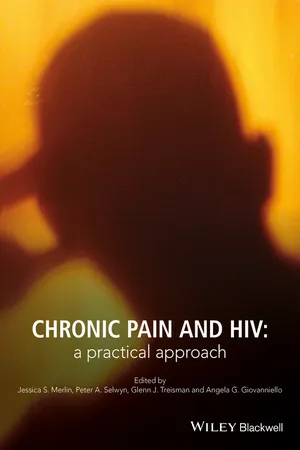
Chronic Pain and HIV
A Practical Approach
- English
- ePUB (mobile friendly)
- Available on iOS & Android
Chronic Pain and HIV
A Practical Approach
About this book
CHRONIC PAIN AND HIV:
a practical approach
Patients suffering from HIV/AIDS often experience chronic pain due to the many diseases and infections they pick up as a result of a weakened immune system. It interferes with their quality of life and physical functioning, impacts adherence to antiretroviral therapy and HIV primary care, and is associated with significant psychological/social distress and substance use disorders.
Chronic Pain and HIV addresses all these complex issues that can influence pain care for the patient with HIV and acts both as a primer and a comprehensive review to define the field of chronic pain management. Using a clear, clinical approach, key topics include the following:
- Musculoskeletal pain in individuals with HIV
- Headache in individuals with HIV
- Psychiatric comorbidities among individuals with HIV and chronic pain
- Potential benefit and harm of prescription opioids in HIV
- Pain at the end of life in individuals with AIDS
- Treatment of chronic pain syndromes in the HIV-infected person.
Edited by an outstanding team with extensive experience in HIV/AIDS and pain/palliative care, every chapter is written by a world-famous expert in their field who provides a thorough review of the relevant literature, including the very latest in management guidelines from the leading international societies.
Perfect for all those in primary care, as well as infectious disease specialists managing patients with HIV/AIDS, Chronic Pain and HIV provides sensible, straightforward clinical advice to ensure the best possible patient management.
Frequently asked questions
- Essential is ideal for learners and professionals who enjoy exploring a wide range of subjects. Access the Essential Library with 800,000+ trusted titles and best-sellers across business, personal growth, and the humanities. Includes unlimited reading time and Standard Read Aloud voice.
- Complete: Perfect for advanced learners and researchers needing full, unrestricted access. Unlock 1.4M+ books across hundreds of subjects, including academic and specialized titles. The Complete Plan also includes advanced features like Premium Read Aloud and Research Assistant.
Please note we cannot support devices running on iOS 13 and Android 7 or earlier. Learn more about using the app.
Information
Chapter 1
Epidemiology of chronic pain in HIV-infected individuals
Introduction
A changing HIV epidemic
Chronic pain in the HAART era
Etiology of chronic pain in HIV
Table of contents
- Cover
- Title Page
- Copyright
- Table of Contents
- Foreword
- About the editors
- List of contributors
- Chapter 1: Epidemiology of chronic pain in HIV-infected individuals
- Chapter 2: Pathophysiology of chronic pain in individuals with HIV
- Chapter 3: Chronic pain assessment, diagnostic testing, and management, with an emphasis on communication about these topics to individuals with HIV
- Chapter 4: HIV and chronic pain: musculoskeletal pain
- Chapter 5: Headache in HIV
- Chapter 6: HIV and peripheral neuropathy
- Chapter 7: Common medical comorbid conditions and chronic pain in HIV
- Chapter 8: Psychiatric comorbidities among individuals with HIV and chronic pain
- Chapter 9: Comorbid substance use among persons with HIV and chronic pain
- Chapter 10: Pharmacologic and Non-Pharmacologic treatment approaches to chronic pain in individuals with HIV
- Chapter 11: Potential benefits and harms of prescription opioids in HIV
- Chapter 12: Safer opioid prescribing in HIV-infected patients with chronic pain
- Chapter 13: The “difficult patient” with HIV and chronic pain
- Chapter 14: HIV-related pain in low- and middle-income countries with reference to sub-Saharan Africa
- Chapter 15: Pain at the end of life in individuals with AIDS
- Chapter 16: Disparities and barriers in management of chronic pain among vulnerable populations with HIV infection
- Index
- End User License Agreement